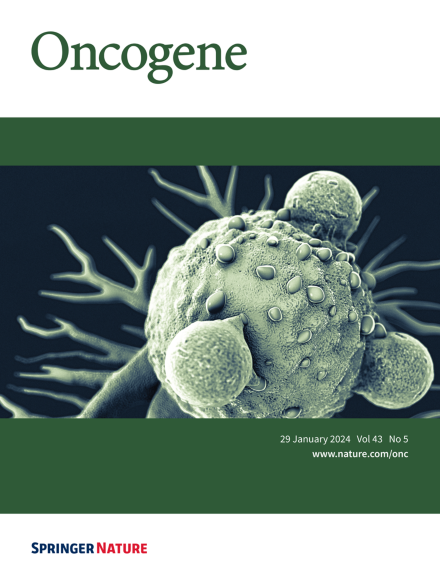SETD5通过m6a介导的PKM2稳定在非小细胞肺癌中促进干性并抑制铁下垂。
IF 7.3
1区 医学
Q1 BIOCHEMISTRY & MOLECULAR BIOLOGY
引用次数: 0
摘要
SETD5是组蛋白赖氨酸甲基转移酶家族的非典型成员,以其与癌症干细胞相关而闻名,是非小细胞肺癌(NSCLC)不利生存结果的重要预测因子。然而,SETD5在NSCLC干细胞中的功能尚不清楚,它是否是一个活性的H3K36me3也存在争议。因此,SETD5在NSCLC干性中的关键作用及其相关机制有待进一步研究。因此,本研究采用非小细胞肺癌组织芯片和生物信息学工具分析SETD5的表达并确定其对干细胞性的影响,并通过体外和体内分析探讨SETD5在非小细胞肺癌转移中的作用。研究结果显示SETD5在胚胎和NSCLC组织中高表达,且与肿瘤病理分期、淋巴结转移及临床分期有关,提示SETD5可作为NSCLC的生物标志物和预后因子。此外,我们发现SETD5可以促进糖酵解,从而抑制铁下垂,促进NSCLC的干性,导致患者肿瘤转移和不良预后。在机制上,SETD5作为H3K36me3促进METTL14的m6A修饰和YTHDF1的募集,介导PKM2核易位和p-PKM2 Tyr105的磷酸化,调节GPX4介导的NSCLC铁沉抗性和SOX9介导的干性。研究结果强调,SETD5可能作为非小细胞肺癌干细胞性的一个有希望的指标,有助于开发非小细胞肺癌的治疗靶点和预后评估。本研究证明SETD5作为H3K36me3促进METTL14的m6A修饰和YTHDF1的募集,介导PKM2的核易位,调节GPX4介导的铁沉抵抗和SOX9介导的干性,导致患者肿瘤转移和不良预后。本文章由计算机程序翻译,如有差异,请以英文原文为准。

SETD5 facilitates stemness and represses ferroptosis via m6A-mediating PKM2 stabilization in non-small cell lung cancer
SETD5, an atypical member of the histone lysine methyltransferase family known for its association with cancer stemness, is a significant predictor of unfavorable survival outcomes in non-small cell lung cancer (NSCLC). However, the function of SETD5 in NSCLC stemness remains unclear, and whether it is an active H3K36me3 is controversial. Consequently, further investigation is required to clarify the pivotal role of SETD5 in NSCLC stemness and its related mechanism. Thus, this study employed the NSCLC tissue microarray and bioinformatics tools to analyze SETD5 expression and determine its effect on stemness and investigated the role of SETD5 in the metastasis of NSCLC using in vitro and in vivo analyses. The findings indicated high SETD5 expression in embryonic and NSCLC tissues, which was related to the pathological tumor stage, lymph node metastasis, and clinical stage, indicating that SETD5 could be used as a biomarker and prognostic factor in NSCLC. In addition, we found that SETD5 can promote glycolysis, thereby inhibiting ferroptosis and promoting the stemness of NSCLC, causing tumor metastasis and adverse prognosis in patients. In terms of mechanism, SETD5 as H3K36me3 facilitates the m6A modification of METTL14 and the recruitment of YTHDF1 and mediates PKM2 nuclear translocation and phosphorylation of p-PKM2 Tyr105, regulating GPX4 mediated ferroptosis resistance and SOX9 mediated stemness in NSCLC. The findings emphasize that SETD5 may serve as a promising indicator of stemness in NSCLC, which can help develop therapeutic targets for NSCLC and prognostic evaluation.
求助全文
通过发布文献求助,成功后即可免费获取论文全文。
去求助
来源期刊

Oncogene
医学-生化与分子生物学
CiteScore
15.30
自引率
1.20%
发文量
404
审稿时长
1 months
期刊介绍:
Oncogene is dedicated to advancing our understanding of cancer processes through the publication of exceptional research. The journal seeks to disseminate work that challenges conventional theories and contributes to establishing new paradigms in the etio-pathogenesis, diagnosis, treatment, or prevention of cancers. Emphasis is placed on research shedding light on processes driving metastatic spread and providing crucial insights into cancer biology beyond existing knowledge.
Areas covered include the cellular and molecular biology of cancer, resistance to cancer therapies, and the development of improved approaches to enhance survival. Oncogene spans the spectrum of cancer biology, from fundamental and theoretical work to translational, applied, and clinical research, including early and late Phase clinical trials, particularly those with biologic and translational endpoints.
 求助内容:
求助内容: 应助结果提醒方式:
应助结果提醒方式:


